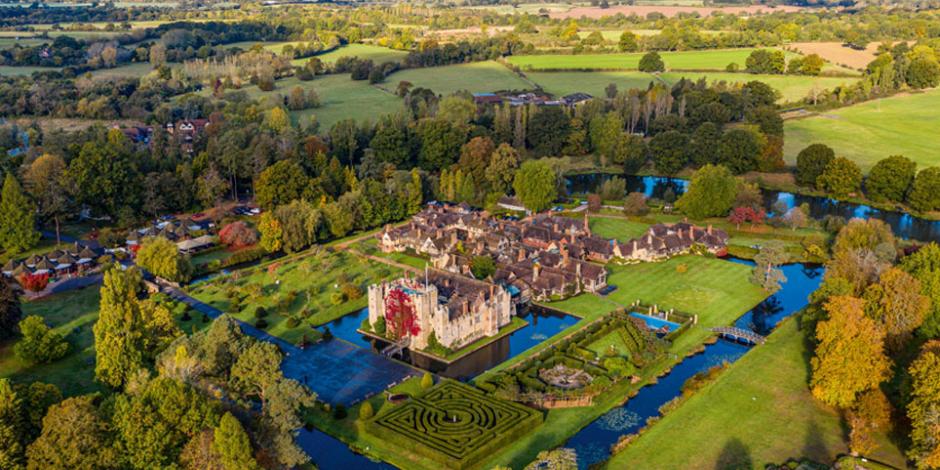What makes a perfect castle? Ancient stone walls, towers, a drawbridgeZugbrückedrawbridge and moat, perfect interiors and prize-winning gardens: Hever Castle has them all – as well as ghosts and a dramatic history. This is a place of medievalmittelalterlichmedieval origins, Tudor passion and the unusual vision of a wealthy American businessman.
Hever lies 50 kilometres south of London, on the Kent/Surrey/Sussex border. In the 16th century, events happened in the castle and grounds that changed the course of Britain’s history. Today, Hever is a place of pilgrimagePilgerortplace of pilgrimage for Tudor enthusiasts. And the ghost of Anne Boleyn, second wife of King Henry VIII and mother of Queen Elizabeth I,
is never far away.
Once upon a time...
Like most visitors, I walk up to the castle along Topiary Walk, where bushes have been transformed into animals and abstract shapes. On my left is Anne Boleyn’s orchardObstgartenorchard and wildflower meadowWiesemeadow, largely unchanged since the 16th century. Old English varieties of apple grow here, including the Flower of Kent, said to be the apple that inspired Newton’s theory of gravitySchwerkraftgravity.
The cream-coloured stone of the gatehouseTorhausgatehouse reflects in the still waters of the moat. This is the oldest part of the castle, dating back to the 13th century. It’s cloakedumhülltcloaked in ivyEfeuivy, which turns a spectacular shade of red in autumn. But what makes Hever Castle so special?
“It’s one of the most beautifully to preserve sth.etw. erhaltenpreserved castles, with some incredible original features that take you immediately back in time,” says Dr Owen Emmerson, historianHistorikerhistorian and castle supervisor.
Anne Boleyn and her older sister, Mary, grew up at Hever. Both were educated and independent, schooled in the royal courts of Europe, where they became well-versedversiertwell-versed in cultural matters and learned languages as well as the latest fashions and styles. And both caught the eye of the king, who was still married to his first wife, Catherine of Aragon, at the time. Mary became his mistressMätresse, Geliebtemistress. Then the king turned to Anne.
“One of the most scandalous courtshipWerben, Liebesaffärecourtships of English history played out at Hever,” says Emmerson. “This is where Henry VIII to come a-courting (arch.)auf Freiersfüßen wandelncame a-courting. And you really are walking in the footsteps of these characters when you visit.”
A few footsteps across the drawbridge take me over the moatBurggrabenmoat, through the gate and into a small courtyard. I’m surrounded on three sides by the timbered facades of the Boleyn family home.
At the entrance, some lucky visitors will be greeted by Henry himself – or at least an actor who looks like him.
Stories from the past
Stepping into the entrance hall is like a journey through time. Timbered ceilings, panelled wallgetäfelte Wandpanelled walls, polished wooden floors: everything I see appears to be a well-preserved original from the Tudor period. In fact, much of it is the result of an early 20th-century renovation carried out by William Waldorf Astor, once the richest man in America.
Astor bought the property in July 1903 and soon began developing his “grand design”. A perfectionist, he insisted that his workers should use, as far as possible, the same materials and tools as Tudor and Elizabethan craftsmanHandwerkercraftsmen. Every room I visit is filled with history; every piece of furniture, painting and tapestryWandteppichtapestry tells stories of the past. Although restored and extended, much of the medieval and Tudor structure
remains.
The magnificentwunderschönmagnificent Inner Hall, panelled, carvedmit Schnitzereiencarved and filled with artwork and antiques, was used by Astor as a reception roomEmpfangssaalreception room. “Believe it or not,” says Emmerson, standing in the middle of the room, “we’re actually in the Boleyns’ Great Kitchen, where thousands of meals were prepared.” He points to details such as the high ceiling, which helped to cope with the immense heat coming from the kitchen fireplaces.
In the drawing roomSalondrawing room, exquisite inlaid panelling covers the walls that once formed part of the 16th-century larderVorratskammerlarder and dairyMilchkammerdairy. The base of a medieval tower has been made into a cocktail cabinetHausbarcocktail cabinet.
The Boleyns of Hever Castle
There are many highlights. Up two flight of stairsFreitreppeflights of stairs, the Long Gallery stretches the entire widthBreitewidth of the castle like a grand museum corridor. It was constructed in the 16th century by Thomas Boleyn, father of Anne and Mary, and used for entertaining guests, taking exercise and displaying art and precious possessions.
The decorative plaster ceilingStuckdeckeplaster ceiling is an early 20th-century reconstruction in the Tudor style. It was made in London and brought to Hever by train. I pause to look at the portraits of the various people who lived in Hever Castle, including Anne Boleyn and Anne of Cleves, the fourth of Henry VIII’s six wives. I wonder what their lives were like here at Hever, a place of luxury but still filled with the pressures of life, and the gossipKlatschgossip, politics and plottingIntrigenplotting of the royal court.
In the Great Chamber, I enter the personal rooms of the Boleyn family. “This is where they would have dined privately and where their children would have been educated,” explains Emmerson. He points to a display case, which contains a small, illustrated book of hoursGebets- und Andachtsbuchbook of hours belonging to Anne Boleyn, complete with her handwriting and signature.
A gang of thieves
Sadly, many other historical treasures were lost in a theftDiebstahltheft at the castle in 1946. “The Daily Mail called it one of the
greatest art robberies of the 20th century,” Emmerson tells me. Two 16th-century psalters were stolen, together with a rare prayer book belonging to Elizabeth I and a daggerDolchdagger belonging to Henry VIII.
In the early hours of Sunday, 21 April, Emmerson explains, a black Rolls-Royce car was seen driving into the castle. Local police thought it must have been Colonel John Jacob Astor returning home. Actually, it was a gang of thieves. They tied up the castle’s nightwatchman and then stole 1,500 valuable items while the Astor family were sleeping in the rooms above.
Further thefts followed, most recently in 2003, when five valuable portrait miniatures were stolen from Anne Boleyn’s bedchamber. Two were recovered, but a rare miniature of Thomas Cromwell, Henry VIII’s chief ministerhier etwa: königlicher Sekretärchief minister, has never been found. Cromwell, the protagonist of Hilary Mantel’s superb Wolf Hall trilogy, was the man behind the rise and fall of Anne Boleyn. When the Boleyns were forced from Hever, Cromwell’s men were there to remove the family’s possessions.
Passion and misdeeds
It was another Queen Anne, however, who caused Cromwell’s downfallNiedergangdownfall. After the king’s third wife, Jane Seymour, died soon after childbirth, Cromwell arranged the disastrous marriage between Henry VIII and Anne of Cleves in 1540. Within six months, the marriage had been annulled and Cromwell beheaded. While the king was planning his next wedding, Anne of Cleves retired to Hever, where she lived for the last 17 years of her life.
Hever’s history of passion and misdeeds continued into the 19th century, says Emmerson. In June 1808, John Humphrey, a local farmer, was shot dead on a Hever footpath. Nobody ever discovered who killed him, but his wife, Mary, was remarried the following year, to a local farmer, who took up the tenancy at Hever.
A letter from the local archives suggests that the farmer “knew more of the matter than he ought”, and that the ghost of Humphrey to hauntverfolgenhaunted the man so badly, he called in the local clergyPfarrerclergy for an exorcism. Humphrey is one of several ghosts reputedly seen at Hever.
Astor’s vision for Hever
Back outside, I’m glad that the sun is still shining: the air seems colder now that I’ve heard Hever’s ghost stories. Bordering the moat on the east side is the Tudor Garden, divided into small, sheltered sections with tidy hedgeHeckehedges, as it might have been in the time of Henry VIII and Anne Boleyn. It features a herbGewürz-, Küchenkrautherb garden and a paved fountainBrunnenfountain with roses. There’s also the unusual sight of a giant chess setSchachfigurenchess set cut from golden yewEibeyew.
“This most likely would have been the kitchen gardens in the Tudor era,” Emmerson explains. “They are probably the most authentic parts of the gardens. The rest of it is an incredible fantasy.”
It’s certainly a convincing fantasy and an inspiring setting. One of the world’s great castle gardens, this was part of Astor’s vision for Hever, which included the construction of the 100-room, 16th-century-style timbered “Tudor village” behind the castle.
In total, the work at Hever is estimated to have cost Astor €12 million at the time (around €1.2 billionMilliarde(n)billion today). “The biggest gift he gave Hever was to re-landscape the grounds,” Emmerson tells me. “He installed some of the most beguilingbetörend schönbeguiling gardens I have ever encountered.”
A gorgeous summer display
The Italian Garden lies at the east end of the formal gardens. Home to 200 of Astor’s classical Greek and Roman statues, it’s alive with colour, especially from the beds of spring tulipTulpetulips: deep purple, red, pink, yellow, orange and white.
On the north side, the Pompeiian Wall hides antiquitiesAntiquitäten; hier: antike Figurenantiquities in stone and marbleMarmormarble under shrubBusch, Strauchshrubs and climbing plants. Along the south side, the Pergola Walk shades fernFarnferns, while camellias and wisteriaGlyziniewisteria climb up the walls. At the very centre lies the Sunken Garden, an oasis of calm and quiet.
Adjacent to the Italian Garden, the Rose Garden is home to 4,000 rose bushes, which form a gorgeousherrlich, fantastischgorgeous summer display of colour. I’m too early for the roses. But it doesn’t seem to matter what time of year you visit Hever – there’s always something to enjoy in the castle, gardens and grounds.
The air is filled with birdsong and the perfume of flowers and blossomBlüteblossom. Trees bear fresh green leaves; there are azaleas and rhododendrons in glorious colours, and bluebellGlockenblumebluebells everywhere. The sound of young voices carries across the water as children enjoy the adventure playground, trails and mazeIrrgartenmazes. The ghost of Anne Boleyn would certainly approve.
Love letters from a king
In the Vatican Library in Rome is a collection of love letters written by King Henry VIII to Anne Boleyn in 1527 and 1528. It’s possible that they were stolen to order from Hever Castle.
The letters prove the king’s infidelityUntreueinfidelity at a time when he was to petition sb.jmdn. ersuchenpetitioning the popePapstPope to annul his marriage to Catherine of Aragon.
In the letters, Henry declares his love for Anne, requests that they meet, and writes that he hopes that Anne “give up yourself body and heart to me, who will be, and have been, your most loyal servant”.
When the Pope refused to annul his marriage, Henry VIII broke with the Catholic Church and married Anne. She survived as queen for just over 1,000 days, before being to beheadenthauptenbeheaded on 19 May 1536.
Neugierig auf mehr?
Dann nutzen Sie die Möglichkeit und stellen Sie sich Ihr optimales Abo ganz nach Ihren Wünschen zusammen.



